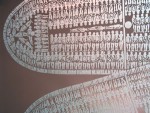Column Name
Title
The power to transform tragedy and disaster into beauty lies at the core of much significant art of our time. This rings especially true for two of the artists in the Rubin Museum’s timely and fascinating exhibition, “Grain of Emptiness: Buddhism-Inspired Contemporary Art.” These artists, Sanford Biggers (born in Los Angeles in 1970) and Theaster Gates (born in Chicago in 1973), transcend artistic boundaries as well as geographical ones, moving from traditional art forms into performance art. The exhibit as a whole features videos, paintings, photographs and installations, including the work of three other artists: Charmion von Wiegand, an American woman who lived from 1896 to 1983; Atta Kim (born in Korea in 1956); and Wolfgang Laib (born in Germany in 1950). The differences in mediums, nationalities, and ages of the artists are striking, but they are all united by the influence Buddhism had on their art and lives. I found the work of Biggers and Bates—both of whom are African American—to be most intriguing.
From a distance, Stanford Biggers’s seven-foot glass etching Lotus looks exquisite and decorative, but up close its details emerge: the petals are the body-stuffed cargo holds of slave ships.
(Photo by Courtesy of the artist and Kavi Gupta Gallery Chicago/Berlin)Theaster Gates’s video Breathing (bottom photos) explores how singers in a choir perform as both individuals and as one voice.
(Photo by Courtesy of the artist and Kavi Gupta Gallery Chicago/Berlin)Body
Biggers is represented by only one piece in the show, but what a piece! In it, he addresses the subject of slavery in an entirely unexpected way: He has transformed the most egregious form of inhumanity into a Buddhist lotus. Using a well-known image published by Thomas Clarkson in 1788-89 of Africans crammed like commodities—“live cargo,” as the phrase went—into every cranny of a slave ship, Biggers has crafted a seven-foot-wide etched-glass disc that hangs over the stairwell. At first glance the glass lotus looks exquisite and decorative—something like an enlarged snowflake. But on further scrutiny, we see that the artist has etched images of human beings as if in a mass grave; these constitute the petals of the giant lotus.
Biggers has constructed the lotus, a magnificent flower that grows from mud, out of the human detritus of history. The parallels continue: they include the transformation from slime to beauty, the transcendence and transparency afforded by the glass, and the paradox of anonymity and coldness producing empathy and understanding. In numerous cultures, the lotus is also an ancient symbol of sun and rebirth since it sinks under the water each night and re-emerges in the morning. The work draws us in, making us complicit in both this appalling history and the potential of healing. By engaging in the paradox of self and nothingness, the artist looks into the essence of Buddhism. He also employs the perfection of the circle in the center, the void, simultaneously filling it with meaning, horror, and beauty. In this work Biggers confronts nothing less than the significance and mystery of our pitiable, short lives, which are the only truth we really know. But in the universe, they are as tiny transparent grains of emptiness.
Like Biggers, Theaster Gates immersed himself in the study of Buddhist culture, which he described as a “guidepost” that helped him imagine things in which he had always believed. For this exhibit Gates has produced an eight-and-one-half minute, four-channel, video installation, Breathing, which was commissioned by the museum. As the artist describes it, four individuals from a choir he founded, the Black Monks of Mississippi, listen to a lead singer sing in the key of D-flat minor, finding harmonies around it so as to envelop her, but never cancel her out. Starting with gospel, they segue into Buddhist chant, and the piece allows us to experience each singer’s individuality, but at the same time they are breathing in synchronicity.
For me—a lifelong choral singer—this had special resonance. I have always been acutely aware of the process of singing together as one voice—never attempting to stand out as an individual, but totally immersing oneself in the whole. When that happens, the power and vibrations can make one feel a tangible connection with the rest of humanity.
Just as Lotus arises out of the degradation of slavery, the music in Breathing stems from spirituals sung by slaves and chain gangs. It’s also infused by the blues of shoeshine men, the forced gaiety of minstrel shows, as well as other communal experiences of hard work and trouble. It evolves from black people singing their hearts out in churches, expressing their hopes and dreams of a better world. It is the aggregation of years of suffering and humiliation. Again, as in the beautiful Biggers work, we observe harmony transcending hardship. The blending of Buddhist chant with gospel, together with the filmed images of the singers, works magically. It is mesmerizing.
As part of the exhibition, both Biggers and Gates scheduled live performances at the Rubin last month. Biggers merged koto, D.J., piano, and vocals into a concert/experimental film that included images as varied as punk, film noir, minstrels, traditional Samoan dance, and Buddhist symbols.
Gates echoed and expanded his video installation by bringing the Black Monks of Mississippi themselves to the galleries to chant meditative sutras, which were layered them with gospel singing at the top of each hour.
Both these artists have used widely divergent mediums and shown their work extensively throughout the U.S. Biggers is known for combining hip-hop culture and black experiences with Buddhism in the form of sand painting and performance. He is especially noted for his demonstrations of human interconnectedness. Likewise, Gates has drawn on his own traditions in combination with Buddhism. Using performance, music, and plans for urban development, he succeeds in creating a bond between people of different classes and cultural backgrounds.
The Rubin exhibit features only five of the numerous artists of the 20th and 21st centuries for whom Buddhist philosophical concepts have been essential. Many of us are familiar with the fascination with Buddhism of John Cage, Merce Cunningham, Jasper Johns, and Robert Rauschenberg. The work of these five lesser-known artists brings a new level of interest to this area. The “emptiness” mentioned in the title of the exhibit refers to the Buddhist paradox dealing with the interdependence of all phenomena. It sees reality as an illusion because nothing can exist on its own.
“Grain of Emptiness” runs through April 11 at the Rubin Museum, 150 West 17 Street, between Sixth and Seventh Avenues. For museum hours and more information, visit rmanyc.org or call (212) 620-5000.






